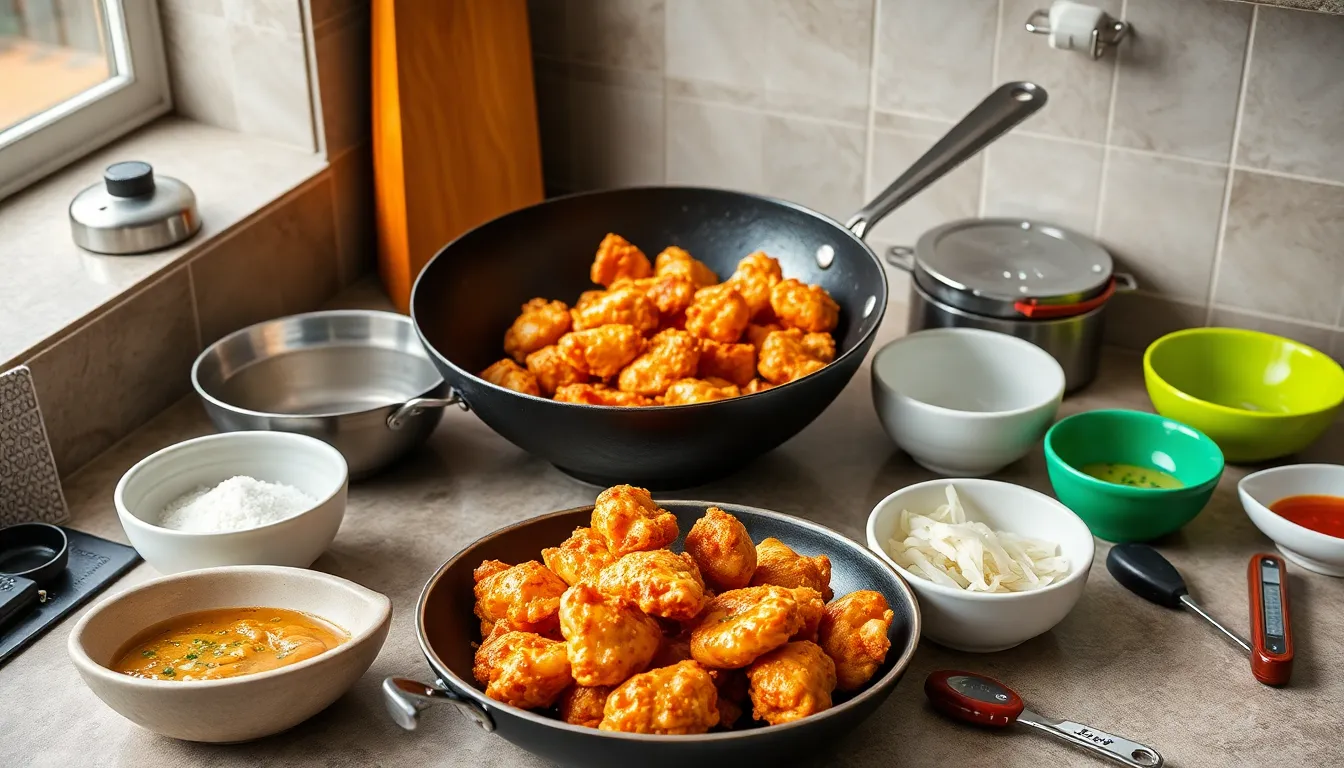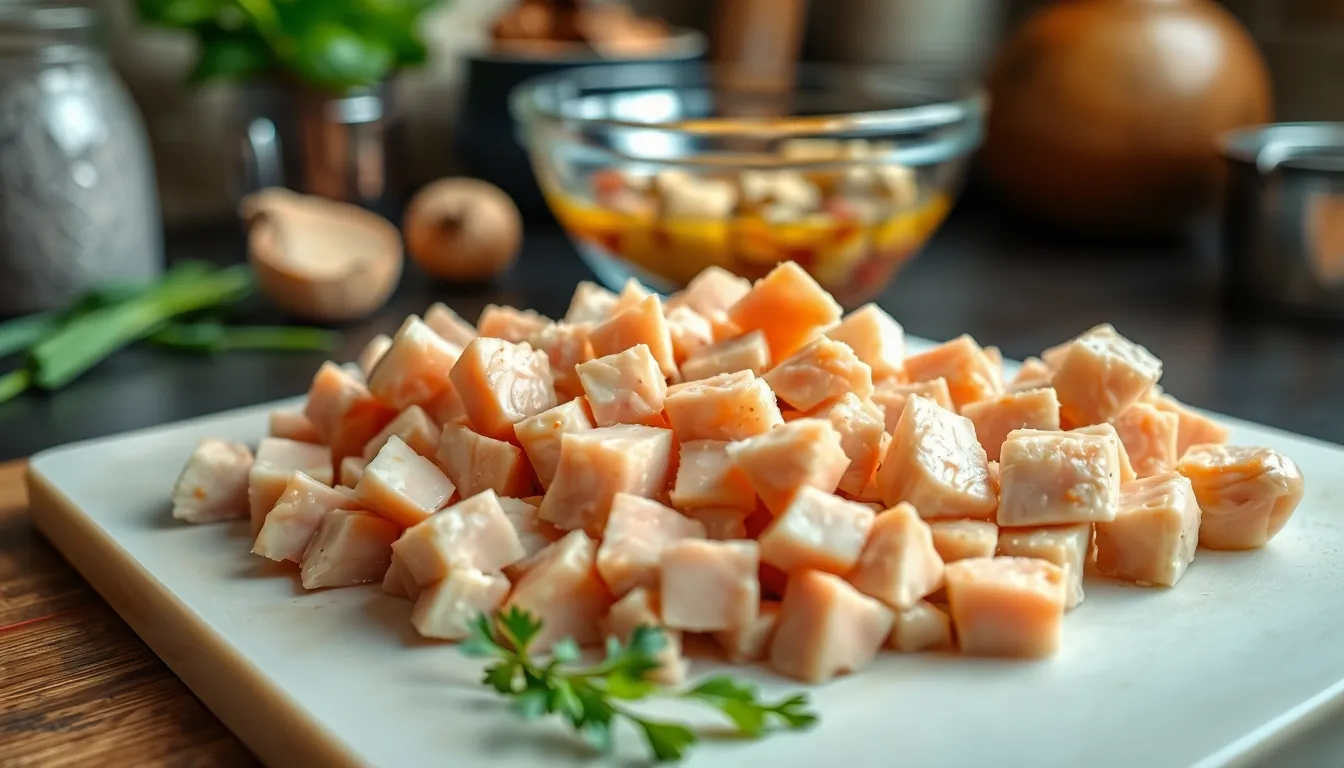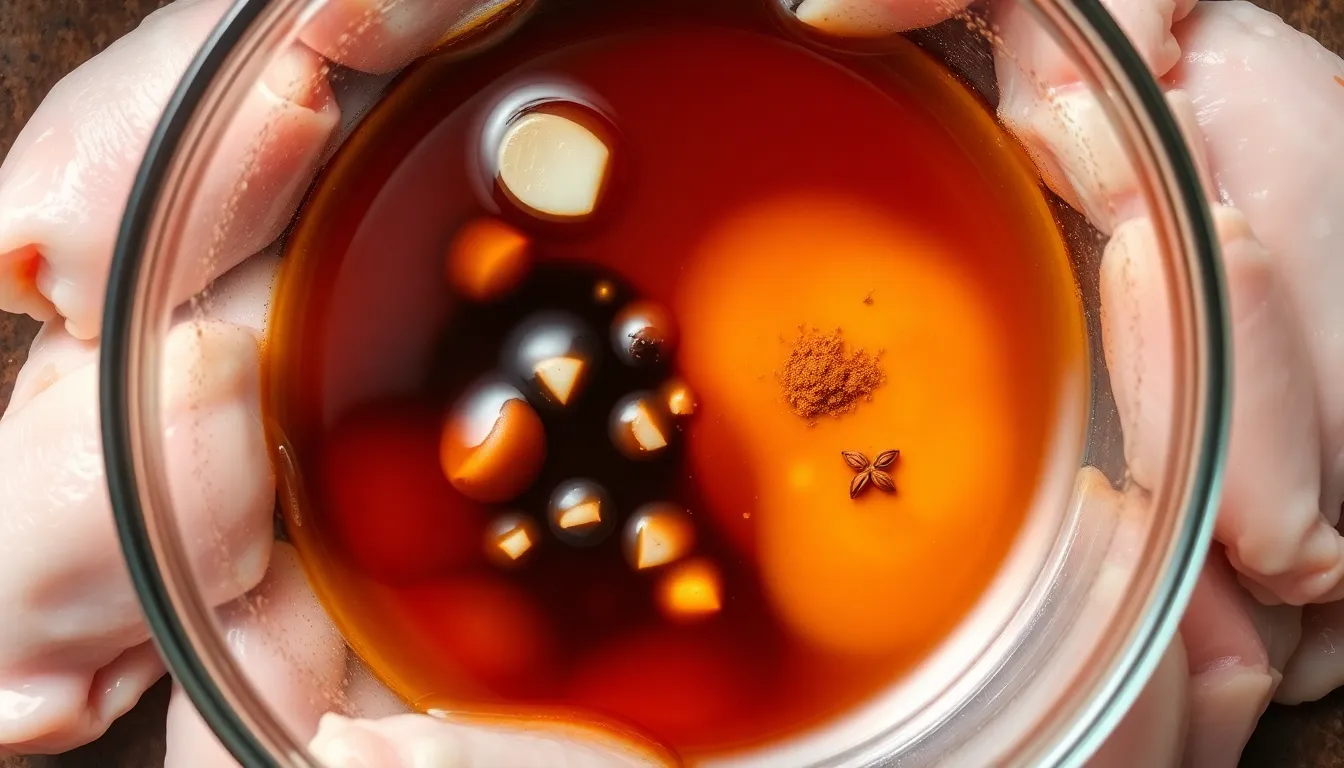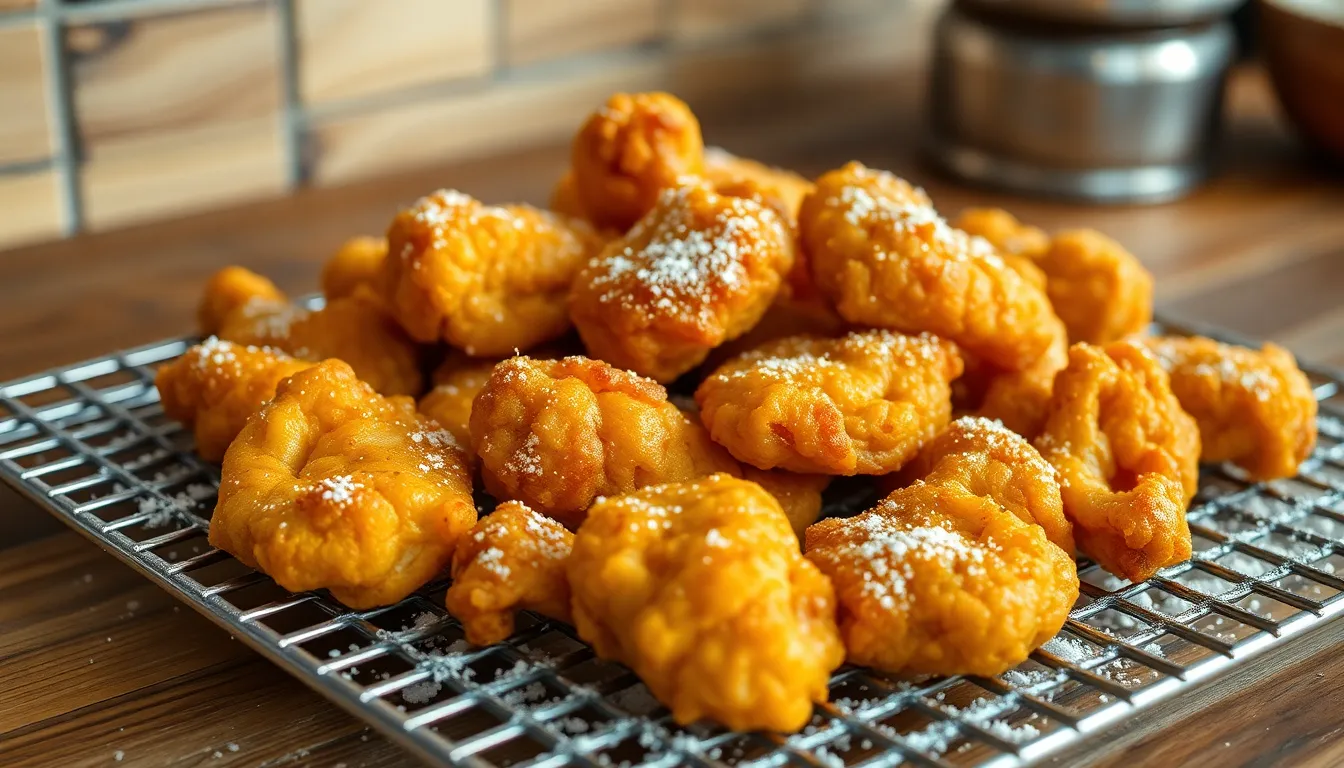Have you ever tasted the crispy, aromatic delight that is Yan Su Ji? This classic Taiwanese popcorn chicken is about to become your new favorite snack!
Yan Su Ji, Taiwan’s beloved street food, combines juicy chicken pieces with a uniquely crunchy coating that’s positively addictive. The secret lies in the sweet potato starch that creates that distinctive crackly exterior while keeping the meat inside tender and flavorful. Unlike ordinary fried chicken, Yan Su Ji features a signature blend of five-spice powder and white pepper that gives it that unmistakable Taiwanese flair.
You’ll find this irresistible snack served in paper bags at night markets throughout Taiwan, but why wait for a trip abroad? With this authentic recipe, you can bring these bite-sized treasures to your own kitchen. The best part? It’s surprisingly simple to make yet guaranteed to impress your family and friends.
What Is Yan Su Ji (Taiwanese Popcorn Chicken)?
Yan Su Ji (鹽酥雞) literally translates to “salt crispy chicken” in Mandarin and represents one of Taiwan’s most beloved street food treasures. This iconic dish features bite-sized pieces of chicken thigh coated in a distinctive crunchy exterior that shatters with each bite. Unlike American-style popcorn chicken which typically uses breadcrumbs or flour, Taiwanese popcorn chicken achieves its signature texture through sweet potato starch.
What sets Yan Su Ji apart from other fried chicken varieties is its aromatic seasoning blend. The chicken gets marinated in a mixture of soy sauce, rice wine, and garlic before being coated and fried. After cooking, it’s tossed with a fragrant combination of white pepper, five-spice powder, and salt. Many vendors also add crispy deep-fried basil leaves that infuse the dish with an herbaceous punch.
You’ll find Yan Su Ji at virtually every night market throughout Taiwan, typically served in paper bags with wooden skewers for easy eating while walking. The dish has gained international popularity in recent years, appearing on menus at Taiwanese restaurants worldwide. Even though its street food origins, this snack offers complex flavors and textures that have earned it a special place in global food culture.
Why You’ll Love This Recipe

This authentic Yan Su Ji recipe delivers the perfect balance of crunchy exterior and juicy interior that makes Taiwanese popcorn chicken irresistible. The sweet potato starch coating creates an exceptionally crispy shell that stays crunchy long after frying, unlike regular flour coatings that often turn soggy quickly.
Your taste buds will be delighted by the complex flavor profile achieved through the savory marinade of garlic, ginger, soy sauce, and Chinese five-spice powder. Each bite offers layers of flavor that build from the aromatic spices to the tender, flavorful chicken beneath.
The addition of fried Thai basil leaves provides a unique herbal element that elevates this dish beyond ordinary fried chicken. These crispy leaves add both visual appeal and a distinctive aroma that complements the rich flavors of the chicken perfectly.
This recipe offers remarkable versatility in both preparation and serving. You can adapt the cooking method to suit your preferences—deep fry for the most authentic experience, air fry for a healthier option, or even bake for minimal hands-on cooking. The seasoning can also be adjusted to your heat preference by varying the amount of white pepper or adding Sichuan peppercorns for a numbing spice note.
Yan Su Ji works wonderfully as a crowd-pleasing appetizer, satisfying snack, or main dish component. The bite-sized pieces make it perfect for sharing at gatherings or enjoying while watching your favorite shows.
Key Ingredients for Authentic Yan Su Ji

Creating authentic Taiwanese salt and pepper chicken requires exact ingredients that deliver its signature crunch and flavor profile. These key components work together to create that perfect balance of textures and tastes that make Yan Su Ji so beloved.
Chicken Thighs
Boneless skinless chicken thighs form the foundation of traditional Yan Su Ji. Cut these juicy pieces into 1 to 1.5-inch chunks to ensure proper cooking while maintaining tenderness. Chicken thighs provide superior flavor compared to breast meat due to their higher fat content, resulting in moist bites that remain succulent even after frying. Their natural richness stands up beautifully to the bold seasonings and high-heat cooking method essential to this dish.
Sweet Potato Starch
The secret to achieving that iconic ultra-crunchy exterior lies in sweet potato starch. Often labeled as “thick” starch in Asian markets, this particular coating creates a distinctively crisp shell that maintains its texture far better than alternatives. Unlike corn starch or rice flour, sweet potato starch produces a more substantial crunch that holds up even as the chicken cools. Apply this coating generously to ensure maximum crispiness in every bite.
Chinese Five-Spice Powder
This aromatic blend serves as the flavor backbone of authentic Yan Su Ji. Traditional Chinese five-spice combines cinnamon, fennel seeds, Sichuan peppercorns, cloves, and star anise in perfect harmony. The complex warmth and subtle sweetness of this spice mixture permeate the chicken during marination and appear again in the final seasoning. Just a small amount transforms ordinary fried chicken into an authentically Taiwanese culinary experience with layers of flavor complexity.
White Pepper
Ground white pepper provides a distinctive heat profile essential to proper Yan Su Ji. Unlike black pepper, white pepper offers a more subtle yet penetrating warmth that complements the five-spice powder perfectly. This ingredient contributes significantly to the characteristic aroma that wafts from freshly made batches at Taiwanese night markets. The clean pungency cuts through the richness of the fried chicken without overwhelming the other seasonings.
Basil Leaves
Thai basil leaves bring brightness and aromatic contrast to this savory dish. Fried alongside the chicken pieces until crisp, these fragrant leaves infuse the oil with their unique flavor while creating textural interest. Thai basil offers stronger anise notes and greater heat resistance than sweet basil, making it ideal for this application. The leaves become delightfully crispy when fried, adding visual appeal and herbaceous complexity that balances the rich flavors of the seasoned chicken.
Essential Equipment

Creating authentic Yan Su Ji requires a few key pieces of equipment to achieve that perfect crispy exterior and juicy interior that makes this Taiwanese popcorn chicken so irresistible. Here’s what you’ll need in your kitchen:
- Mixing Bowls – You’ll need at least two: one for marinating the chicken and another for the sweet potato starch coating. Opt for medium to large sizes that give you enough room to work with the ingredients.
- Microplane or Grater – Fresh garlic and ginger form the aromatic base of the marinade, and a good microplane helps extract maximum flavor by finely grating these ingredients.
- Measuring Spoons and Cups – Precise measurements ensure your five-spice powder, white pepper, and other seasonings are perfectly balanced for authentic flavor.
- Wok or Deep Heavy-bottomed Pan – The traditional choice for frying Yan Su Ji is a wok, which provides even heat distribution and requires less oil than a standard pot. If you don’t have a wok, any deep heavy-bottomed pan will suffice.
- Cooking Thermometer – For perfect crispiness, maintain your oil temperature between 350-375°F (175-190°C). A thermometer helps prevent overheating or underheating your oil.
- Slotted Spoon or Spider Strainer – These tools allow you to safely add and remove chicken pieces from hot oil while letting excess oil drain away.
- Paper Towels or Wire Rack – Place your freshly fried chicken on paper towels to absorb excess oil or on a wire rack to maintain maximum crispiness.
- Small Bowl for Seasoning Mix – Prepare your final seasoning blend of salt, five-spice powder, white pepper, and garlic powder in a small bowl for sprinkling over the hot chicken.
With these essential tools at your disposal, you’ll be well-equipped to create authentic Taiwanese salt and pepper chicken that rivals the street food stalls of Taiwan. The right equipment makes the process more efficient and helps ensure consistent results every time you prepare this crowd-pleasing dish.
Preparation

Proper preparation is the foundation of authentic Yan Su Ji, ensuring each bite delivers that perfect balance of crispy exterior and juicy interior. Follow these crucial steps to set up your Taiwanese popcorn chicken for success.
Cutting the Chicken
Select skinless boneless chicken thighs for your Yan Su Ji as they provide superior juiciness and flavor compared to breast meat. Trim any excess fat from the thighs before cutting them into uniform bite-sized chunks approximately 1 to 1.5 inches each. Consistency in size matters tremendously for even cooking and achieving that signature texture contrast. Pat the chicken pieces dry with paper towels before marinating to ensure better absorption of flavors and prevent excess moisture that could affect the crispiness of your final result.
Making the Marinade
Create a flavorful base by combining aromatic elements with traditional seasonings in a medium bowl. Mix 2 tablespoons of light soy sauce (or coconut aminos for a gluten-free option) with 1 tablespoon of Shaoxing rice wine and 1 teaspoon of sweet soy paste. Add 2 cloves of minced garlic and 1 teaspoon of freshly grated ginger for aromatic depth. Incorporate 1 teaspoon of Chinese five-spice powder along with 1/2 teaspoon of sugar to balance the flavors. For tenderization, include 1/4 teaspoon of baking soda and 1/2 teaspoon of salt. Beat an egg or egg yolk separately and add it to the mixture to help the coating adhere better to the chicken pieces. Toss your chicken chunks thoroughly in this marinade until each piece is evenly coated. Transfer everything to a sealed container and refrigerate for at least 2 hours or preferably overnight to allow the flavors to fully penetrate the meat.
The Perfect Marinade

The secret to exceptional Yan Su Ji lies in its deeply flavored marinade that tenderizes the chicken while infusing it with a complex array of savory, sweet, and aromatic elements. Your chicken will absorb these distinctive Taiwanese flavors, creating that authentic taste that makes this street food so addictive.
To create the perfect Yan Su Ji marinade, combine:
- 1.5 tablespoons light soy sauce
- 1 tablespoon Shaoxing rice wine or beer
- 1/8 to 1/4 teaspoon Chinese five-spice powder
- 3-5 garlic cloves, minced
- 1 teaspoon sugar
- 1/2 teaspoon salt
- 1/2 tablespoon regular soy sauce
- 1/4 teaspoon baking soda (crucial for tenderizing)
- 1 egg (whole or just the yolk)
Mix these ingredients thoroughly in a bowl until well combined. The baking soda works as a tenderizer that breaks down the protein structures in the chicken, ensuring each piece remains juicy after frying. The egg creates a protective coating that helps the sweet potato starch adhere better during the later coating process.
Pour this marinade over your bite-sized chicken thigh pieces and massage it in with your hands to ensure each piece is thoroughly coated. Transfer the chicken to an airtight container or seal it in a zip-top bag, then refrigerate for at least 30 minutes. For optimal flavor development, let it marinate for 2 hours or even overnight.
The Shaoxing wine adds depth while the five-spice powder contributes warm aromatic notes that define authentic Taiwanese popcorn chicken. Garlic and ginger provide pungent undertones that complement the savory soy sauce base. This balanced marinade ensures your Yan Su Ji will have that distinctive night market flavor profile that makes it impossible to stop at just one piece.
While your chicken marinates, prepare the “Jiao Yan” seasoning mixture by toasting Sichuan peppercorns until fragrant, then crushing them and mixing with salt, white pepper, and additional five-spice powder. This aromatic blend will be sprinkled over your chicken after frying, adding that characteristic numbing sensation and complex flavor that makes Yan Su Ji truly special.
Coating the Chicken

The coating process is where your Yan Su Ji truly develops its signature crunch. After marinating the chicken pieces thoroughly, remove them from the refrigerator and let them sit at room temperature for about 15 minutes. This ensures more even cooking when you fry them later.
Sweet potato starch serves as the primary coating agent for authentic Yan Su Ji. Unlike regular flour or cornstarch, sweet potato starch creates an exceptionally crispy exterior that maintains its crunch even after cooling. Pour approximately 1 cup of sweet potato starch into a shallow bowl or plate for easy dredging.
Working with small batches of 5-6 pieces at a time, lift the chicken from the marinade allowing excess liquid to drip off. Drop each piece into the sweet potato starch and toss until completely coated on all sides. The thick starch coating is essential for achieving the distinctive crunchy texture that makes Yan Su Ji stand out from other fried chicken recipes.
For an extra crispy result, press the starch firmly onto each chicken piece. This technique creates those characteristic craggy edges that become ultra-crunchy when fried. Some Taiwanese street vendors double-dip their chicken by quickly dunking the coated pieces back into the marinade and then into the starch again for an even thicker coating.
Place the coated chicken pieces on a wire rack or plate, keeping them separated to prevent sticking. Let them rest for 5-10 minutes before frying to allow the coating to adhere properly to the meat. This resting period helps the starch absorb moisture from the marinade, creating a better bond between the chicken and coating.
If you’re preparing a large batch, coat only what you can fry immediately. Keeping chicken pieces waiting too long can cause the starch to become soggy from the moisture in the meat. The goal is to maintain that dry starch coating until the moment it hits the hot oil, transforming into the crispy shell that Yan Su Ji is famous for.
Frying Instructions

Achieving the perfect crispiness that defines authentic Yan Su Ji requires precise frying techniques. Follow these detailed instructions to create that signature crunchy exterior while maintaining juicy, flavorful chicken inside.
Oil Temperature Guide
Heat neutral oil in a wok or deep saucepan to 350°F (175°C) for the initial fry. You’ll know the oil has reached the right temperature when the surface shimmers slightly. Maintain this medium heat throughout the first frying stage to cook the chicken thoroughly without burning the coating. For the second fry, increase your oil temperature to approximately 400°F (205°C). This higher temperature creates that extra crispy exterior that makes Yan Su Ji so irresistible. Using a cooking thermometer helps maintain these precise temperatures for consistent results every time.
Batch Frying Tips
Work with small batches when frying your chicken pieces to prevent overcrowding the oil. Overcrowded oil drops in temperature quickly and results in soggy rather than crispy chicken. During the first fry, cook the chicken for 2-4 minutes until it develops a golden brown color. Remove the pieces with a slotted spoon or spider strainer and let them drain on a wire rack or paper towel-lined plate. Allow the oil to return to 400°F (205°C) before beginning your second fry. Return the partially cooked chicken to the hotter oil for about 1 minute until it becomes extra crispy with a satisfying crunch. Immediately after removing from oil, toss or sprinkle the chicken with your prepared Jiao Yan seasoning while still hot. For an authentic finishing touch, quickly fry fresh Thai basil leaves in the hot oil for just 5-10 seconds until crisp, then add them to your finished chicken for a fragrant aromatic element that elevates the entire dish.
Serving Your Yan Su Ji

Present your freshly fried Yan Su Ji immediately while it’s hot and crispy for the most authentic experience. This popular Taiwanese street food shines brightest when served steaming hot with all the traditional accompaniments.
Traditional Garnishes
Fried Thai basil leaves are the quintessential garnish for authentic Yan Su Ji. These aromatic leaves add a distinctive herbal flavor and slight spiciness that perfectly complements the savory chicken. Unlike sweet basil, Thai basil possesses a stronger flavor profile that stands up to the robust seasoning of the dish. Simply drop a handful of fresh Thai basil leaves into the hot oil for a few seconds until crisp, then scatter them over your freshly fried chicken pieces.
The finishing touch for your Yan Su Ji comes from a sprinkle of “jiao yan” seasoning. Create this traditional seasoning blend by grinding together toasted Sichuan peppercorns, white pepper, salt, and additional five-spice powder. The Sichuan peppercorns provide a subtle numbing sensation that enhances the overall eating experience. Apply this seasoning liberally while the chicken is still hot to help it adhere better to the crispy exterior.
Dipping Sauce Options
While traditional Yan Su Ji is flavorful enough to enjoy without additional sauces, you can offer simple dipping options to elevate the experience. Create a balanced dipping sauce using soy sauce-based pastes mixed with a touch of sugar to achieve the perfect harmony between saltiness and sweetness. The subtle sweetness helps highlight the complex spice profile of the chicken.
Many Taiwanese night market vendors rely solely on the post-frying seasoning blend rather than separate dipping sauces. The “jiao yan” seasoning mentioned above serves as both a garnish and flavor enhancer, eliminating the need for additional condiments. Serve your Yan Su Ji in a paper cone or basket lined with parchment paper for an authentic night market presentation. This dish pairs exceptionally well with cold beer, making it perfect for casual gatherings or as an appetizer before a larger meal.
Storage and Reheating

After enjoying your homemade Yan Su Ji, you might find yourself with leftovers that are too good to waste. Proper storage and reheating techniques will help maintain that signature crispiness and flavor that makes this Taiwanese popcorn chicken so irresistible.
Storing Leftover Yan Su Ji
Allow your freshly made Yan Su Ji to cool completely to room temperature before storing. This prevents condensation from forming inside your storage container, which would make the chicken soggy.
Place the cooled chicken in an airtight container lined with paper towels. The paper towels absorb excess moisture, helping to preserve the crispiness of the coating.
Refrigerate your leftover Yan Su Ji promptly and consume it within 3-4 days for optimal freshness and food safety. Never leave the chicken at room temperature for more than two hours to prevent bacterial growth.
Best Methods for Reheating
The microwave is not your friend when it comes to reheating Yan Su Ji, as it will leave you with disappointingly soggy chicken. Instead, try these superior methods to restore that coveted crunch:
Re-frying Method (Best Option)
- Heat oil in a wok or deep pan to approximately 150°C (300°F)
- Add fresh Thai basil leaves to infuse the oil with flavor
- Allow the oil to reach a high temperature
- Quickly re-fry the chicken pieces for 30-60 seconds until hot and crispy
- Remove and drain on paper towels
- Sprinkle with additional Jiao Yan seasoning if desired
Stovetop Method
- Preheat a wok or skillet over high heat
- Add a small amount of oil
- Toss the leftover Yan Su Ji pieces quickly to reheat
- Stir frequently to ensure even heating without burning
- Remove once hot and crispy (approximately 2-3 minutes)
Air Fryer Method
- Preheat your air fryer to 180°C (350°F)
- Place chicken pieces in a single layer in the basket
- Reheat for 3-5 minutes until hot and crispy
- Shake the basket halfway through for even heating
Food Safety Tips
Ensure reheated Yan Su Ji reaches an internal temperature of at least 60°C (140°F) before consumption. This temperature kills any potential bacteria that may have developed during storage.
| Storage/Reheating Method | Maximum Storage Time | Temperature | Time |
|---|---|---|---|
| Refrigeration | 3-4 days | Below 4°C (40°F) | N/A |
| Re-frying | N/A | 150°C (300°F) | 30-60 seconds |
| Air Fryer | N/A | 180°C (350°F) | 3-5 minutes |
| Stovetop | N/A | High heat | 2-3 minutes |
For the best taste experience, reheat only the amount you plan to eat immediately. Multiple reheating cycles will diminish both flavor and texture, taking away from the authentic Yan Su Ji experience you worked so hard to create.
Conclusion
Yan Su Ji stands as a testament to Taiwan’s vibrant street food culture with its irresistible combination of crispy exterior and juicy interior. This beloved popcorn chicken isn’t just about taste—it’s about technique and tradition.
By following the authentic preparation methods outlined here you’ll bring the exciting flavors of Taiwanese night markets into your kitchen. The sweet potato starch coating and distinctive jiao yan seasoning are what elevate this dish beyond ordinary fried chicken.
Whether served in paper cones as a casual snack or presented as an impressive appetizer you’ll find Yan Su Ji is worth the effort. Master this recipe and you’ll have a crowd-pleasing dish that captures the essence of Taiwan’s culinary magic right at your fingertips.
Frequently Asked Questions
What is Yan Su Ji?
Yan Su Ji is a popular Taiwanese street food that translates to “salt crispy chicken” in Mandarin. It features bite-sized pieces of chicken thigh coated in sweet potato starch, creating a uniquely crunchy exterior. The chicken is marinated in soy sauce, rice wine, and garlic, then fried and seasoned with white pepper, five-spice powder, and salt, often garnished with crispy basil leaves.
What makes Yan Su Ji different from regular popcorn chicken?
The key difference is the coating – Yan Su Ji uses sweet potato starch instead of regular flour, creating an ultra-crunchy exterior that stays crispy longer. It also features a complex flavor profile from Chinese five-spice powder, white pepper, and fried Thai basil leaves. The marinade penetrates deeper into the meat, resulting in juicier, more flavorful chicken compared to American-style popcorn chicken.
Why use chicken thighs instead of breast meat?
Chicken thighs contain more fat and collagen than breast meat, resulting in juicier, more flavorful pieces that remain tender after frying. They’re less likely to dry out during the cooking process, creating the perfect balance between the crispy exterior and moist interior that makes authentic Yan Su Ji so irresistible.
What is sweet potato starch and can I substitute it?
Sweet potato starch is a fine powder made from sweet potatoes that creates an exceptionally crispy coating when fried. While cornstarch or tapioca starch can be substituted, they won’t produce the same distinctive crackly texture that makes Yan Su Ji special. For authentic results, seek out sweet potato starch at Asian grocery stores or online.
What is the “Jiao Yan” seasoning mixture?
Jiao Yan is the signature seasoning blend that gives Yan Su Ji its distinctive flavor. It typically includes white pepper, five-spice powder, salt, and sometimes MSG or chicken powder. This mixture adds a complex, aromatic quality with a slight numbing sensation that enhances the overall taste profile of the dish.
Why does the recipe require double frying?
Double frying is essential for achieving the perfect texture. The first fry at a lower temperature (350°F/175°C) cooks the chicken through, while the second fry at a higher temperature (400°F/205°C) creates the extra-crispy exterior. This technique ensures juicy meat inside and the signature crunchy coating that defines authentic Yan Su Ji.
Can I make Yan Su Ji in an air fryer?
Yes! While traditional deep-frying produces the most authentic results, air frying works well as a healthier alternative. Spray the coated chicken pieces with oil, air fry at 380°F for about 10-12 minutes, turning halfway through. The texture won’t be identical to deep-fried, but you’ll still get delicious crispy chicken with significantly less oil.
How do I store and reheat leftovers?
Store cooled leftovers in an airtight container lined with paper towels in the refrigerator for up to 3-4 days. To maintain crispiness when reheating, use an air fryer at 380°F for 3-4 minutes, or reheat in a 375°F oven for 5-7 minutes. Avoid microwaving as it will make the coating soggy.
What should I serve with Yan Su Ji?
Serve Yan Su Ji immediately after cooking with fried Thai basil leaves and an extra sprinkle of the seasoning mixture. For an authentic experience, serve in a paper cone or basket. While flavorful on its own, you can offer simple dipping sauces like sweet chili or sriracha mayo. It pairs perfectly with cold beer for casual gatherings.
Is Yan Su Ji gluten-free?
Traditional Yan Su Ji is not gluten-free due to the soy sauce in the marinade. However, you can easily make it gluten-free by substituting tamari or gluten-free soy sauce. The sweet potato starch coating is naturally gluten-free, making this adaptation simple for those with gluten sensitivities while maintaining the authentic flavor and texture.
